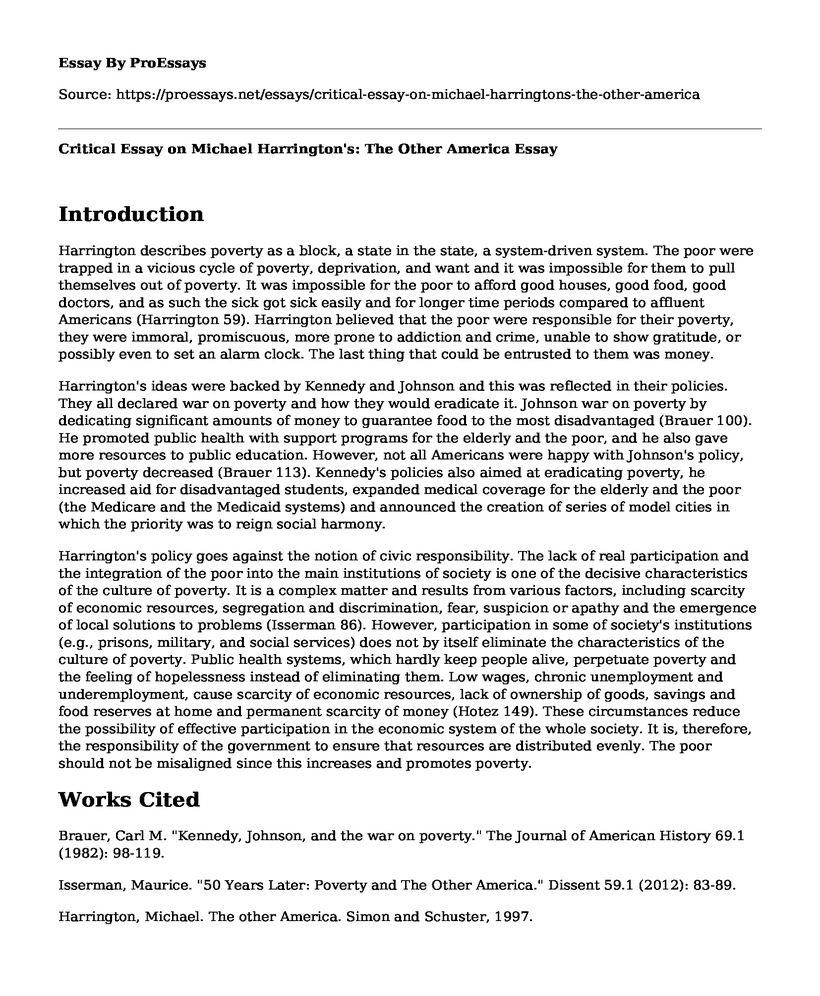Introduction
Harrington describes poverty as a block, a state in the state, a system-driven system. The poor were trapped in a vicious cycle of poverty, deprivation, and want and it was impossible for them to pull themselves out of poverty. It was impossible for the poor to afford good houses, good food, good doctors, and as such the sick got sick easily and for longer time periods compared to affluent Americans (Harrington 59). Harrington believed that the poor were responsible for their poverty, they were immoral, promiscuous, more prone to addiction and crime, unable to show gratitude, or possibly even to set an alarm clock. The last thing that could be entrusted to them was money.
Harrington's ideas were backed by Kennedy and Johnson and this was reflected in their policies. They all declared war on poverty and how they would eradicate it. Johnson war on poverty by dedicating significant amounts of money to guarantee food to the most disadvantaged (Brauer 100). He promoted public health with support programs for the elderly and the poor, and he also gave more resources to public education. However, not all Americans were happy with Johnson's policy, but poverty decreased (Brauer 113). Kennedy's policies also aimed at eradicating poverty, he increased aid for disadvantaged students, expanded medical coverage for the elderly and the poor (the Medicare and the Medicaid systems) and announced the creation of series of model cities in which the priority was to reign social harmony.
Harrington's policy goes against the notion of civic responsibility. The lack of real participation and the integration of the poor into the main institutions of society is one of the decisive characteristics of the culture of poverty. It is a complex matter and results from various factors, including scarcity of economic resources, segregation and discrimination, fear, suspicion or apathy and the emergence of local solutions to problems (Isserman 86). However, participation in some of society's institutions (e.g., prisons, military, and social services) does not by itself eliminate the characteristics of the culture of poverty. Public health systems, which hardly keep people alive, perpetuate poverty and the feeling of hopelessness instead of eliminating them. Low wages, chronic unemployment and underemployment, cause scarcity of economic resources, lack of ownership of goods, savings and food reserves at home and permanent scarcity of money (Hotez 149). These circumstances reduce the possibility of effective participation in the economic system of the whole society. It is, therefore, the responsibility of the government to ensure that resources are distributed evenly. The poor should not be misaligned since this increases and promotes poverty.
Works Cited
Brauer, Carl M. "Kennedy, Johnson, and the war on poverty." The Journal of American History 69.1 (1982): 98-119.
Isserman, Maurice. "50 Years Later: Poverty and The Other America." Dissent 59.1 (2012): 83-89.
Harrington, Michael. The other America. Simon and Schuster, 1997.
Hotez, Peter J. "Neglected diseases, and poverty in "The Other America": the greatest health disparity in the United States?" (2007): e149.
Cite this page
Critical Essay on Michael Harrington's: The Other America. (2022, Nov 17). Retrieved from https://proessays.net/essays/critical-essay-on-michael-harringtons-the-other-america
If you are the original author of this essay and no longer wish to have it published on the ProEssays website, please click below to request its removal:
- Essay Sample on Elder Abuse
- Women at the World's Colombia Exposition
- Violence in Downtown Los Angeles Essay
- Drug Abuse in Athletes: The Need for Weed Essay
- Animal Abuses Essay Example
- Essay Sample on Creating Safe Spaces: Exploring Eli Clare's Activism for Queer and Disabled People
- Essay Sample on Labelling Theory: Racism & Criminal Justice System







